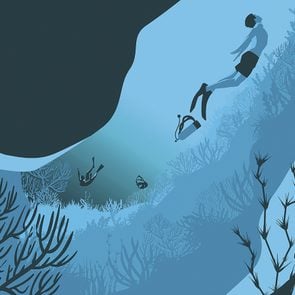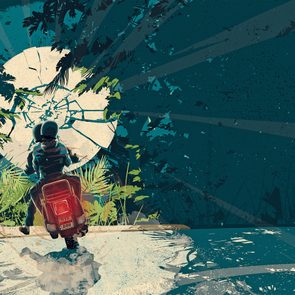When a Speeding Boat Severed His Arm, This Diver Fought to Survive
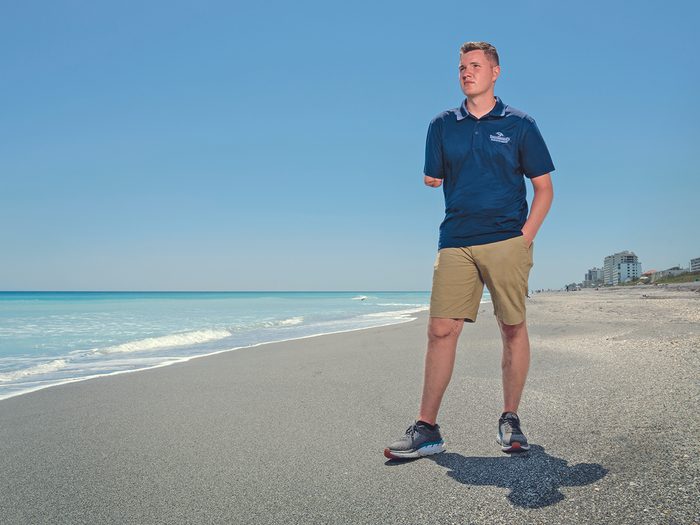
After a speeding boat nearly killed Carter Viss, he vowed to work with the driver to make sure it never happens again.
Beneath the ocean’s surface waits a different world—quiet, full of wonder, shimmering with life. Carter Viss loved that world. It’s why he left Colorado to study marine biology at Palm Beach Atlantic University. It’s why he got a job at the Loggerhead Marinelife Center, just up Highway 1 on Florida’s east coast. And it’s why he spent so much free time snorkelling in the reef system just a couple hundred metres from the famous Breakers resort in Palm Beach.
This particular Thursday morning— November 28, 2019—was especially nice. It was Thanksgiving. Tourists and locals alike hit the beaches. The water was flat, the sky blue and the underwater visibility spectacular. Twenty-five-year-old Viss and his 32-year-old co-worker, Andy Earl, spent a couple of hours among the sharks, eels, turtles, octopus, lionfish and angelfish. They netted some small specimens for Viss’s personal collection. Finally, around noon, they headed for shore.
To a diver underwater, outboard engines have a clear, unmistakable sound. On the surface, however, swimming the crawl, Viss didn’t hear the powerboat until it was almost on top of him. When he saw it, he knew he had just an instant. He pulled desperately to one side, getting his head and upper torso out of the boat’s path before it ran him over.
He braced and tumbled. The seawater around him turned crimson. A severed limb was sinking to the bottom—a human arm, the hand enclosed in a black diver’s glove.
This couldn’t be happening, he thought. It was too bizarre.
Inhaling blood and seawater, Viss realized he would drown if he didn’t swim. But he couldn’t swim. His right arm was gone. Both his legs were smashed, dangling uselessly beneath him, and his remaining hand was damaged. Screaming for his life, he slipped beneath the surface.
Andy Earl heard his friend’s mortal terror. So did Christine Raininger, an expat Canadian who was sitting on a paddleboard nearby and had yelled at the boat to slow down. They reached Viss at about the same time. While Andy kept Viss’s face out of the water, Christine squeezed his upper arm to stem the blood flow, then fashioned a tourniquet from the cord on her paddleboard.
Meanwhile, the 11-metre speed-boat, named Talley Girl, was reversing urgently. It was powered by three massive 400-horsepower Mercury outboard engines with five-blade propellers. On board were retired Goldman Sachs executive Daniel Stanton Sr., his 30-year-old son, Daniel Jr., his son-in-law and two grandchildren. Daniel Jr. was at the wheel. Horrified, in shock, he helped Earl and Raininger load Viss onto the dive platform at the boat’s stern.
I’m not going to make it, Viss thought, pain searing through the adrenalin. No way I’m gonna make it.
Earl, too, feared his friend’s wounds were not survivable. “God is with us,” he reassured Viss, over and over, holding his hand as Talley Girl made for shore. “God is with us.”
Viss, a devout Christian, felt his fear and panic melt away. In its place came total surrender, a kind of blissful acceptance. Dying felt like diving down into another beautifully peaceful realm.

As it turned out, the worst day of Viss’s life was not without things to be thankful for. Earl and Raininger being so close, for one. The speedboat reversing so quickly. The first responders who waded into the ocean to meet Talley Girl. The ambulance that raced to St. Mary’s Medical Center. The 12-person critical-care team, already briefed and suited up, that received Viss in the trauma bay barely 20 minutes after the boat strike.
Also fortunate was the fact that Dr. Robert Borrego, a critical-care surgeon and the medical director of trauma at St. Mary’s, was in the middle of his shift. The son of a Cuban fisherman, Borrego had come to America at age nine. Thirty years at St. Mary’s and a stint at a field hospital in Iraq had acclimatized him to dealing with massive trauma.
Many soldiers he’d worked on had been devastated by improvised explosive devices. Borrego did a quick assessment. Major open wounds in the ocean are doubly perilous because the victim’s bleeding is not slowed by clotting and infection is very likely. Viss was clearly in Stage 4 shock, meaning he’d lost at least 40 per cent of his blood volume and was on the verge of multi-organ failure. His right arm had been retrieved by a diver, but there was no hope of reattaching it.
Borrego noted the damaged left hand and wrist. The right knee was dislocated and deeply lacerated, the kneecap was nearly severed and the femur had a fracture. The lower left leg and ankle were smashed, with deep gashes in the flesh. The left foot was turning blue.
It was a miracle Viss had gotten to the hospital alive, but every moment counted. One option was to amputate both legs. Amputation could be done quickly and would lower the risk of infection. Because Viss was young and otherwise healthy, Borrego and his team decided it was worth trying to save them.
Three surgeons and two residents set to work together. First came a guillotine amputation of the mangled stump of his arm. That wound would need to be regularly trimmed and washed with antibiotics to ensure it was infection-free before being closed. Next, each leg was reset and encased in a fixator, a sort of exoskeleton that maintains proper alignment as the bones begin their slow process of repair. Fractures in the left hand and wrist were also set and soft-tissue damage repaired. Three and a half hours later, liberally infused with saline and eight units each of red blood cells, plasma and platelets, Viss was moved to the ICU.
The next 48 to 72 hours would be critical. The human body can only fight so many battles at once before shutting down. All anyone could do now was wait, and hope, and see if he’d pull through.
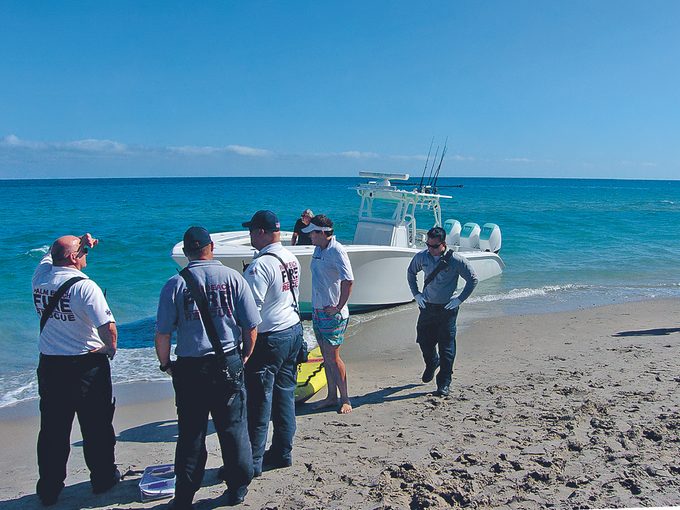
In Centennial, a town outside Denver, Chuck and Leila Viss were taking a chilly, snowy walk after Thanksgiving Day church service when Leila’s cell- phone rang. The call display showed a Florida number. She assumed it was a telemarketing robocall.
Back in the car, heading home to start dinner, she saw there were two voicemail messages. She put the phone on speaker so Chuck could listen, as well. It was a sheriff in Palm Beach County. As the mother of three active boys—Carter was her middle son— Leila wondered: what’s Carter done?
“Boating accident… lost one arm… trying to save his legs.”
Panicked, weeping, they pulled into a parking lot. “We took turns losing
it and comforting each other,” said Leila. The day became a desperate, blurry scramble—cancelling dinner, urgent calls, sobbing helplessly, work plans, trying to book flights on a holiday. Chuck’s persistence paid off when he found two seats out of Denver that evening, with a layover in Boston.
If there’s such a place as purgatory, it just might resemble Logan Airport at 4 a.m. when you’re so emotionally spent that you’ve run out of tears, unsure whether your son would be alive when you reached him. And daring to contemplate whether, if he ended up with just one limb, it might be better if he passed—this young man who lived to snorkel and fish and play guitar and piano.

If Logan Airport is purgatory, a hospital’s ICU could be the high-stakes room in a casino. You can’t tell whether it’s day or night. People move with purposeful efficiency. The atmosphere is generally calm but intense. The difference, of course, is that what’s at stake in a hospital is not just money but life itself.
Frayed and exhausted, Leila and Chuck Viss reached St. Mary’s around 10 a.m. The sight of their son in the ICU, swollen and bandaged, right arm missing, fixators on his legs and tubes down his throat, was overwhelming. Leila and Chuck had to be helped out to compose themselves.
So began their vigil. The Visses took turns by his bedside, where Carter was hooked up to a ventilator. He was tormented by hallucinations—“ICU psychosis,”doctors call it. He knew his family was there, tearful and comforting, but so were strange, gruesome creatures that were crawling all over him.
“Get them off me,” he begged.

Viss didn’t know he’d already had four operations. Infected flesh had been excised, a titanium rod inserted in his shattered tibia and hardware installed in his left wrist and right knee. Nor did he recall the many emotional visits he’d had from church friends and Loggerhead colleagues.
Chuck, as an employee of Oracle, the software company, was able to work remotely. Leila, a church organist and piano teacher, needed to be back in Centennial. So Chuck took up residence in a nearby condo and Leila commuted.
One morning, after Viss had been extubated, Borrego told him the battle was 90 per cent won. I’ve got a long road ahead of me, Viss realized, but I’m gonna make it.
He decided he would use his spared life to educate others about ocean safety and conservation. Heading into yet another surgery, he told his parents, “I can make a bigger difference now than I ever could before.”
Over the 68 days Viss spent in hospital, his recovery felt agonizingly slow. Actually, says Borrego, it was remarkably fast. His parents noted each milestone. The first day he sat up. Being moved out of ICU to a “step-down” room. The first time, after surgery on the nerves in his right knee, that he wiggled his toes. The first time he sat in a wheelchair. The first day he ate the hospital Jell-o and chicken broth Chuck had brought him. The morning he wore his own clothes. And then, a week later, Viss standing unaided, and a few days after that his first shaky, excruciatingly painful steps.
But another battle had just begun. Heavy doses of morphine, oxycodone and fentanyl had eased his pain. Now, as Borrego explained to the Visses, a successful outcome depended on Carter getting off opioids: “I’ve seen many lives ruined when patients can’t break free.”
The Visses have friends who’ve lost family members to overdoses. Carter, too, understood the gravity of the issue. He gradually reduced his dosages until, determined to use nothing more than Advil and medical marijuana, he tore off his fentanyl patch. Withdrawal made for a harrowing few days, but then Viss, as Borrego puts it, “has incredible mental strength, just extraordinary.”
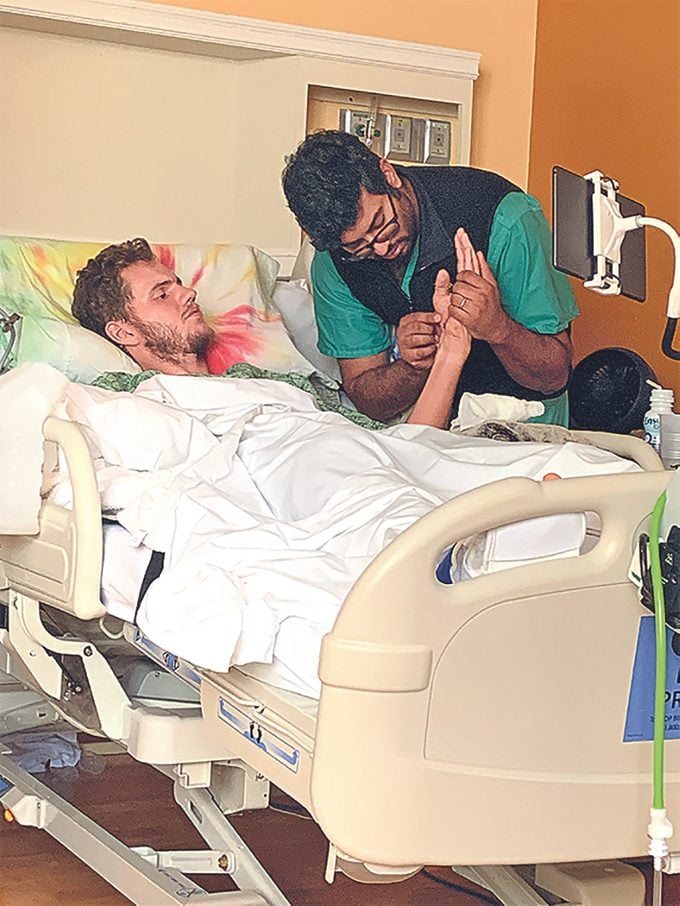
Viss was discharged from St. Mary’s in February 2020. By June, just seven months after the accident, he returned to work. His duties aptly include helping with the rehabilitation of loggerhead sea turtles that have been injured in boat strikes.
Today he can bend his right knee only 90 degrees. For a while, residual infections had him on and off antibiotics. He’s been fitted with a prosthetic arm but finds it cumbersome. All in all, says Borrego, his recovery has been almost miraculous.
Physical healing is one thing. The emotional legacy is less obvious, more nuanced. “The accident itself,” Viss says, “I try not to remember how real it was, the panic and horror. It feels more like remembering a dream now, or a nightmare. And I try not to think of what I can’t do and focus on ways to work around things.”
An investigation by Florida Fish and Wildlife found that Talley Girl had been going at least 80 kilometres per hour when it struck Carter. The agency faulted Stanton Jr. for operating a vessel within 90 metres of diver-down warnings; reckless operation of a vessel; failing to maintain a safe speed; and failing to maintain a proper lookout.
Last September, Stanton was charged with wilful and reckless operation of a vessel, a first-degree misdemeanour punishable by up to a year in jail. “The prosecutor gave us several options,” says Chuck Viss. “Carter insisted he did not want Stanton to face incarceration. He said, ‘I’d rather have him working with me on ocean safety than sitting in a jail cell.’”
A civil suit was settled out of court, and last November the terms of Stanton’s criminal plea agreement were made official. The court hearing marked the first time Carter and Daniel Stanton Jr. had seen each other since the day both their lives changed.
Leila and Chuck Viss had flown in from Denver. Stanton’s mother, Mary, was there with her son. Stanton Sr. attended via Zoom. Everyone wore protective masks because of the COVID- 19 pandemic. The two families avoided eye contact.
Viss read a victim-impact statement and then Daniel Stanton Jr. addressed him directly. Viss knew that the remorse was genuine and profound. “There was no doubt how he felt,” his father agreed. “You could see the pain in his eyes.”
Judge Robert Panse confirmed the plea deal. Stanton Jr. was sentenced to 75 hours of community service, a year’s probation, a US$1,000 fine and a mandate to work with Viss on legislation to enhance ocean safety and conservation. Afterward, Viss went to Stanton Jr. and shook his hand. Tears flowed and the wall of silence between the families came down. As the two men embraced, Viss said quietly, “Let’s make a difference.”
One of their ideas is a better “diver down” marker. The current design is a red flag with a diagonal white stripe. Depending on wind direction, however, a boater may not see it. Viss favours a bigger, three-dimensional buoy, visible in any weather, with reflective strips.
In addition, Viss wants to see strict speed enforcement. Most boat-strike victims are simply people swimming off the beach. Close to shore, at a popular spot, a speedboat planing at high speed makes no sense.
Has the legal resolution led to forgiveness? “Forgiveness comes from the heart,” says Carter. “I feel like I’m going in the right direction. If I were him and had to live with the guilt and remorse, I’d almost prefer to be in my shoes. It’s a complex thing emotionally, but if I can ease someone else’s pain, I will.”
Next, read the amazing story of how this man was stung by killer bees thousands of times and survived.

